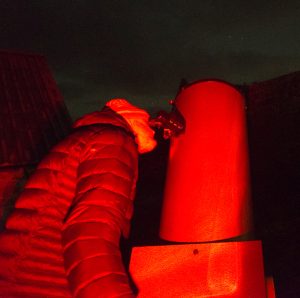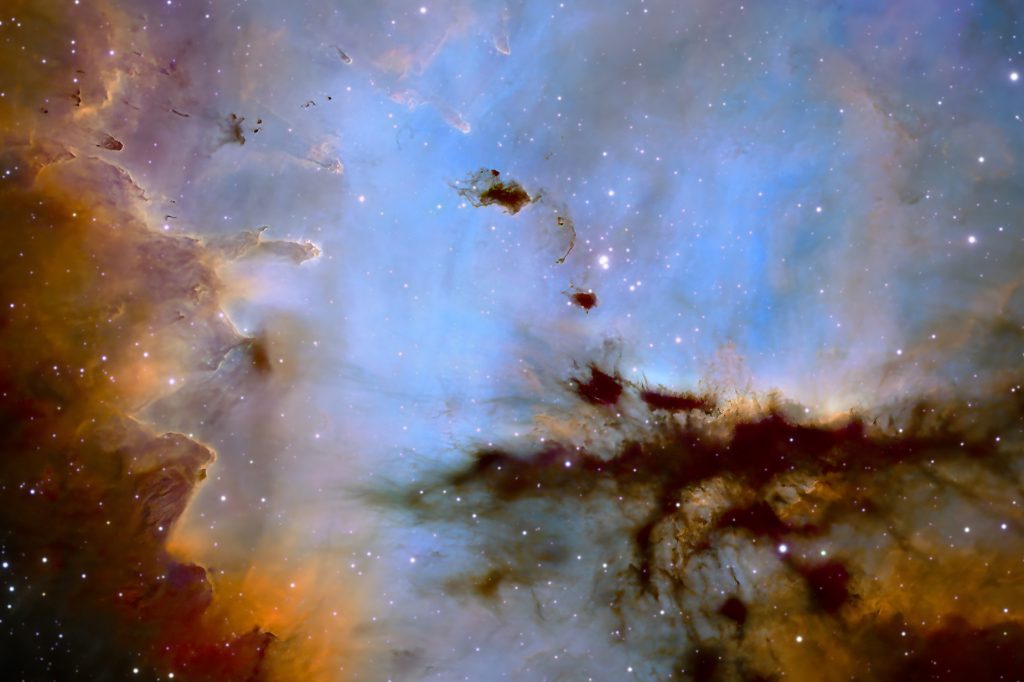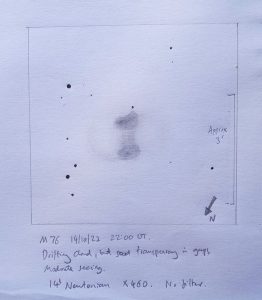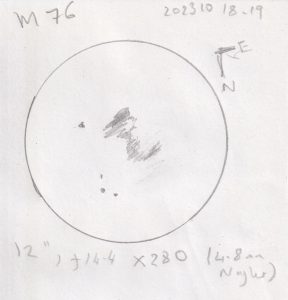2023 November 6
Deep Sky Update – October 2023
It was mentioned that the email version of the update does not always format well so I have been experimenting with sending this out as an HTML email. So this is the first ‘real’ message. I have embedded links but not images. I hope this does not fall foul of spam filters, please let me know if it does end consigned to your spam folder or if normally receive it but did not this time round.
 I hope you managed to get some observing done in October. Although not a vintage year at the Kelling Heath Autumn Star Camp I hear there were a couple of good nights.
I hope you managed to get some observing done in October. Although not a vintage year at the Kelling Heath Autumn Star Camp I hear there were a couple of good nights.
Weather in Orkney has been generally ‘windy’ or ‘quite windy’ – we had a record monthly electricity production from our wind turbine since we moved here. And there were a few cancellations of our local ferry due to wind and tide combinations, which have been unusual. However I did have one very good night which saw an outing for my re-worked 12-inch dob. My first attempt at a new spider was not very successful, so I replaced this with a curved spider arrangement which was much more successful. I was puzzled though that my 17.3mm Delos eyepiece would not come to focus, whilst the 10mm did – I had thought these were parfocal. Some googling revealed that in fact the 17.3mm is not parfocal with the rest of the range. After thinking about many possible solutions I decided on just making a lower profile 2 inch to 1¼ inch adapter which was not particularly difficult with my 3D printer. But back to my observing session – I went for a good number of easy targets as I’m really out of practice, including M76, M57, the double double, Albireo, the Witches Broom NGC 6960, the Blue Snowball NGC 7662, the Deer Lick galaxy NGC 7331, and finally M15 as it set behind the house. I’m still not happy with my out-of-focus stars. Maybe the mirror is a bit pinched or the 6 point cell is not working well – I had been thinking about reworking it as a 9 point so may try that.
Deep Sky Zoom – January 2024
I mentioned before the intention to have another Deep Sky webinar, and have chosen January 11th at 19:30 GMT, so please put this in your diary. If you would like to give an up to 30 minute presentation at the webinar please let me know as soon as possible.
Planetary nebula nucleus in the open cluster M37
This interesting paper came to my attention, not least because Peter Goodhew, one of our members, is a co-author. The full title is “The unusual planetary nebula nucleus in the Galactic open cluster M37 and six further hot white dwarf candidates”, and it is open-access and published by Astronomy & Astrophysics.
September Object of Interest
September’s object was Messier 76, the Little Dumbell, and I was pleased to see that it generated much interest, from both imagers and visual observers. Images were posted by Alan Thomas, Pat Devine, Mark Fairfax, Simon Davis and Iain Cartwright. Here is Iain’s image made with a Nikon D810A with x2 ED Barlow (2″) on a Sky-watcher 200PDS.

I also received visual observations from Martin Foad and Jim Latham.
Martin observed it on two occasions; one with a 500mm dob and on a second night with a 300mm dob. Martin noted that “an OIII filter and a UHC with the 300mm scope, but for me personally I found they didn’t help, and the view was better for me without any filters”. Here are Martin’s two sketches.
Jim observed on several nights, also sketched and writes: “I first saw M76 in 1978 through a wobbly 4.5″ reflector and I recall feeling quite triumphant when I finally tracked it down. No such problems with the 14″ – a relatively bright and easy object to locate.
I viewed M76 several times between October 13th and 16th. We had a lot of cloud passing through but with occasional transparent gaps between when I could be bothered to wait. The main dumbbell shape was very clear, with each lobe an irregular oval, and connected by a nebulous bridge. The southern lobe had a brighter central ‘ridge’ with quite a sharp concentration that possibly was a star. With averted vision I could detect a subtle ‘cotton wool’ texture to the lobes and hints of ‘strings’ in the bridge. There was an approx.14th mag star just off the well-defined edge of the southern lobe. Looking at photos this star appears embedded within quite bright red nebulosity that I didn’t notice at all visually. The outer ‘wings’ of the nebula were faintly seen, with the western one brighter and appearing as a distinct curl from the northern lobe.
|
|
I tried various magnifications with x460 being most effective at showing detail. An OIII filter improved contrast, but at the expense of dimming the image. The wings were most obvious at x280 with OIII filter, which brought out a gentle outer glow around most of the nebula.”
I actually observed on two nights as well, though the second night was quickly curtailed by cloud. M 76 is quite an easy star hop from Almach (gamma And) to 51 And which is a nice yellow star with another closeby, and then onto blue phi Per, and then it’s just a short nudge north to arrive on the target. It was easily visible in the 300mm aperture dob with a 32mm TV Plossl, and showed nicely in the 10mm Delos. I then tried my 4.8mm Nagler which is the shortest focal length eyepiece I have, and I was quite surprised how nice it was. My recollection was that this eyepiece was rather difficult to use in the past, but here I found it really nice. Perhaps it’s the first time I have tried it since having had the cataract lens replacement. Above is my rather rudimentary sketch.
Object of Interest for November
For November I decided to stick with the Planetary Nebula theme, and I think it will be interesting to see what you make of IC 289 – a PNe in Cassiopeia. For visual observers it will be a real challenge for medium scope users (in his Members’ Album, Patrick Maloney notes with his sketch that it was quite hard with a 12 inch dob), and for imagers its one arc-minute diameter will require a good image scale.
Deep Sky Picture of the Month

From October’s postings to Members Albums I’ve chosen this closeup of the Pacman Nebula (NGC 281) by Norman Gray. Really remarkable detail captured in this long exposure taken over several days from Stevenage.
And Finally
Sorry this update is a bit later than I like to post it – I have been rather distracted by displays of the northern lights this weekend!
Clear, dark skies,
Callum
| The British Astronomical Association supports amateur astronomers around the UK and the rest of the world. Find out more about the BAA or join us. |



